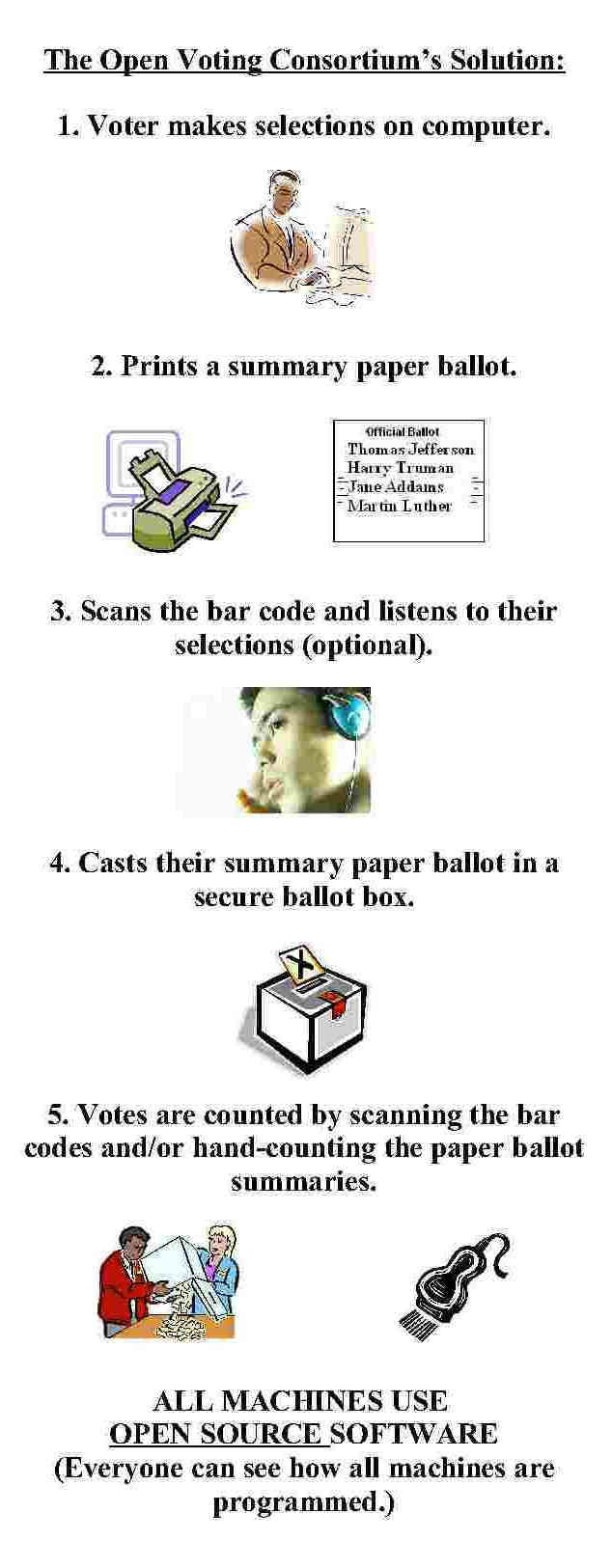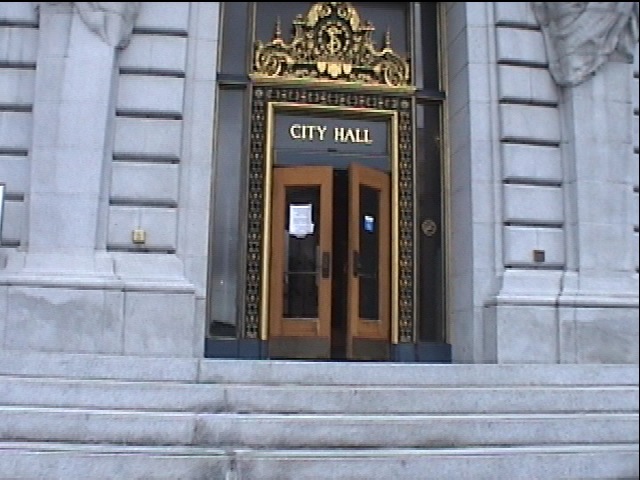GOODBYE MONEY
HAVA: the Feds giveth and the Feds
taketh away
In my first year of law practice, a new client signed a retainer agreement and then counted out five dollar bills on the desk. “Goodbye Money!” he exclaimed in a tone both dramatic and rueful. I think of him often-–I didn’t put him in the situation where he needed my help, but it was plain that he could have used the money for something more lasting than my services. I’m tight with a buck, and I respect others who are too. And I expect our public servants to be.
The Help America Vote Act (HAVA) saga still unfolds, but it is clear that it already is a government boondoggle of a high, if not the highest, order. After the Florida election debacle of 2000, the federal government got the idea of doling out huge sums to the states for new and improved voting equipment. Do you think election equipment giants Diebold and ES&S did any lobbying for this bill?
Advocates for the disabled saw this as an opportunity to achieve their long time goal of having disability-friendly voting equipment. They jumped in and got the mandate they wanted: a requirement that every polling place in the country have equipment that enables the disabled to vote privately and independently.
It was reasonable for them to demand this-–after all, we would all be going to electronic voting systems (DREs), right? And with DREs, it’s cheap to add on an audio menu, some headphones, and a sip/puff tube that will facilitate independent voting for the disabled. Voters would all use the same equipment, so the added cost of the disability mandate would be minimal.
But it didn’t turn out that way. Funny business with the DREs, including counting failures, security breaches, and partisan statements by the company owners have led many Americans to distrust them. Demands for a “paper trail” have stopped the stampede to DREs in states around the country.
Here in Minnesota we were never part of that stampede. We have a paper trail, and we are going to keep one. Neither the Secretary of State nor her opponents dispute that point. But the consequence is that we are staying with our optical scan machines and buying more of them. Optical scan machines cannot be adapted to meet the disability mandate which took effect this year. We were required to provide a separate disability-accessible device for every polling place in Minnesota by the time of the primary in September. And that’s where the big money went.
Minnesota’s share of the federal HAVA funds (so far) was $44 million. About $5 million was earmarked for the statewide voter registration system. With the remaining $39 million, our first obligation was to provide disability equipment. The only machine certified was the ES&S Automark. The state contract negotiated by Mary Kiffmeyer calls for a price of nearly $5000 for each machine. 4000 polling places needed the machine. There’s $20 million right there–more than half of our available HAVA funds.
That’s an enormous sum for a few thousand people. Even if there were as many as 20,000 blind, visually impaired, or dexterity-challenged voters who are not voting absentee, that would be $1000 per voter. Put another way, 50% of the money is going for less than 1% of the voters. Another consequence is that we will have fewer polling places simply to avoid buying more disability accessible machines. That means a longer drive for many outstate voters.
I hear what you’re saying. You grinch. Please understand, I want to accommodate the disabled voters. At a mock election in December, I blindfolded myself for half an hour to test a new voting device. Just that brief experience helped me feel the frustration of being at the mercy of strangers when trying to accomplish something most of us take for granted: marking a secret ballot. Later, I observed the pride of the blind and otherwise challenged voters who came a long way to this event to demonstrate their determination to do this on their own.
We are paying monopoly pricing under an artificial deadline for a less than optimal product
But even the disabled voters didn’t want taxpayers to spend half of the federal funds just for them alone. If we are using optical scan as our base system, then ideally the disability station should produce a compatible optical scan ballot at a reasonable price. The technology is not mature yet when only one vendor can provide the item. And it’s not even compatible with all of scanners we have. (The Automark ballot is not readily compatible with the Diebold scanners owned by Ramsey, Washington, Dakota, and Anoka Counties.) We paid monopoly pricing under an artificial deadline for a less than optimal product. Couldn’t we have waited a year or two to let the technology mature and to get some competitive pricing for these products?
Apparently not. A bill to extend the deadline, HR 3163, introduced by Republican Virgil Goode of Virginia, languished in Washington. Mary Kiffmeyer should have lobbied for the extension, but instead she is lobbying for more HAVA funds to be disbursed.
"ES&S now has Park Place and Boardwalk."--County election official
Kiffmeyer urged the Diebold counties to buy the ES&S Automark and eventually they did. She remarked that the federal funds were sufficient to buy it, and we want the best elections, not the cheapest. But this isn’t an issue of quality versus price. The Automark is a poor fit. Any federal money used up for machines that are inadequate will not be available for service and maintenance costs down the road. And in the four Diebold counties, those costs will be high since they will require two different companies to come out to service, upgrade, and test the machines.
I respect the officials of Ramsey, Washington, Anoka, and Dakota for trying to get more for their taxpayers’ money. Madame Secretary, these federal dollars are not a gift from the sky. We are all federal taxpayers too--in fact, Minnesota taxpayers probably will put in about $54 million to get the $44 million back. It used to be that Republicans were stingy with a buck. Mary Kiffmeyer is of a new breed of Republican who puts taxpayer concerns on the back burner.
Kiffmeyer proudly wasting our money
Article about Anoka County's issues
But do you have a better idea?
I'm working on it. Open Voting Consortium holds the promise of an inexpensive system, with equipment you can buy at a store, software that is developed by volunteers and fully transparent to ensure security, and a voter-friendly interface that is easily accessible for disabled voters, all with a paper trail. And, I should add, fully capable of processing ranked ballots. Estimated price per machine is 1/5 of what ES&S charges.

Digression: How do you put a price tag on the ability of disabled voters to vote privately and independently? This is an intangible thing. The disabled advocates for this cause are very passionate. The ability to vote without a stranger, or even a friend, peering over our shoulder is something most of us take for granted. But the price cannot be infinity. I think we can all agree that if the cost were $1 per voter we would be more than happy to pay. But I doubt if anybody, even the most adamant advocate for the disabled, would claim that the right to voting privacy was worth $1 million per voter.
So there, we’ve established that the price per voter is somewhere between $1 and $1 million!
You could say that $20 million for the whole state is not too much, because that’s only $4 per Minnesotan. But that argument could be used for any request for taxpayer funds–-you hear that sort of argument made frequently for stadiums. If we spend $20 million on disability voting equipment, what other worthwhile endeavors are left by the wayside? It’s true that these federal funds can only be spent on voting equipment and voting related expenses, but the more a county can use federal funds for election needs, the more they have of their own funds to spend on other needs.
Could you ask disabled voters, OK, I can give you cash or I can give you the right to vote privately for the next ten years. At what price will you say give me the cash? Ask them what they would do with $20 million if they could spend it on any benefit for the disabled. Would they spend it on voting machines? That would be a way of measuring the value of voting privately to the people affected. The answers you get might vary widely from individual to individual.
These are the types of questions that government officials often face. Or should face. So the next time you slam politicians, consider how you would speak publicly about such a sensitive issue. It’s not easy.
What do you think about this? How do you put a dollar sign on an intangible right? E-mail your thoughts to bruce@bk4sos.org.

